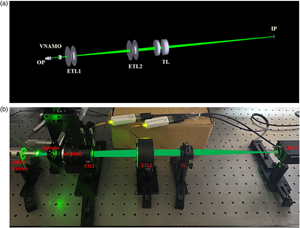Published online by Cambridge University Press: 21 December 2021

Maintaining telecentricity and zooming in microscopic systems with prolonged depths of focus is a difficult challenge because these properties degrade while moving to different axial planes in the extended focal depth. In this paper, we propose the proof of concept for an automated dual-mode microscopic system that combines two electrically tunable lenses (ETLs) with a variable numerical aperture controller placed. It acts as a viable solution to allow both multiplane microscopic zooming and telecentricity with consistent image resolution throughout the objective's extended focal depth. The image plane remains fixed for both the modes of operation, namely telecentricity and multiplane zooming. To validate the performance of the proposed idea, both simulations and experiments are carried out at various ETL curvature ranges. Over the whole zoom distance range, the experimental zoom ratio is determined to range from −2.723X to −34.42X. The experimental and simulation findings are compared and found to be quite similar, with magnification error percentages of 2.26% for zoom mode and 1.27% for telecentric mode. The comprehensive explanation of simulation and experimental results demonstrate the feasibility of the proposed method for both multiplane zoom and telecentric operations on a single platform in microscopic applications.